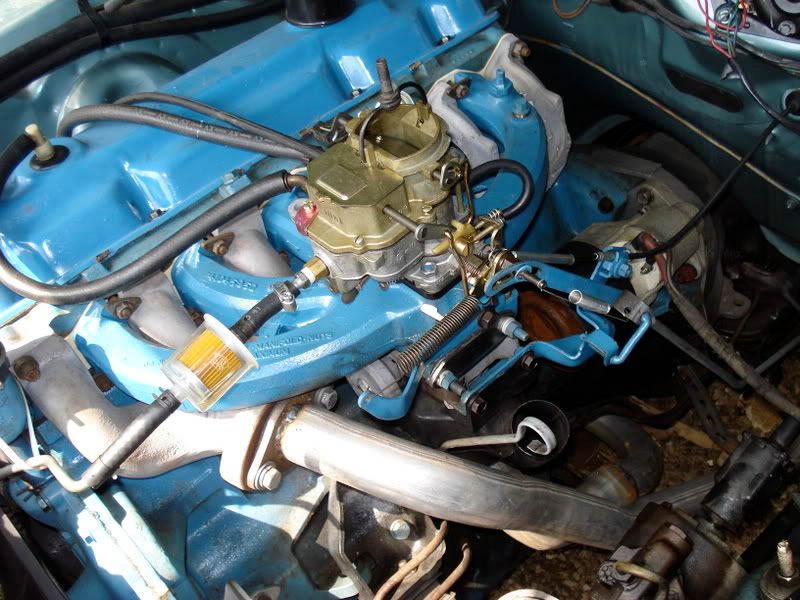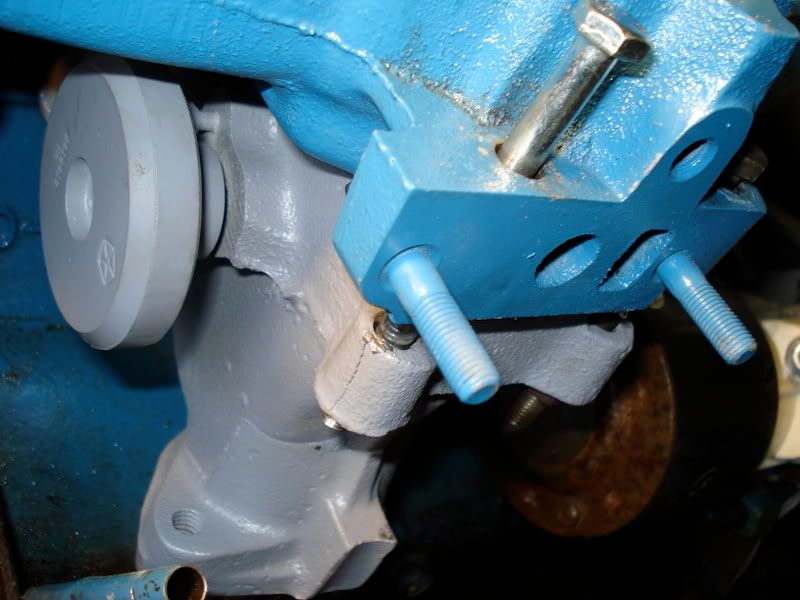for 15 dollars you can block it off and not have to worry about any of this
as shown here

before the $15.00 EGR block off plate is installed

| Slant Six Forum https://slantsix.org/forum/ |
|
| Does anybody have vacuum diagrams for a 225 w/EGR? https://slantsix.org/forum/viewtopic.php?t=30208 |
Page 2 of 3 |
| Author: | SlantSixDan [ Mon Jun 01, 2009 7:50 pm ] |
| Post subject: | |
Quote: I hope to achieve some knowledge on how to properly hook up an EGR.
Well, the way the factory did it is described in my previous post to this thread. Other makers have done it differently.Quote: Wouldn't a properly working EGR reduce NOX emission and allow me to run more timing with less chance of ping at light cruise at operating temp?
Theoretically, yes, but generally extracting a real benefit from this requires modern precisely (computer) controlled EGR and ignition timing in conjunction with high compression and a knock sensor. The EGR we're working with on the slant-6 is pretty stone-age, and only very gross/rough control of it is possible. Running more advance is just a method of trying to get back some of what the EGR takes away. A directly comparable situation is that of operating a naturally-aspirated engine at elevations above sea level. The air is less dense (less oxygen per unit volume), so power output and tendency to ping are both reduced. Advancing the ignition timing beyond the (sea level) factory spec can get back some of what the less dense atmosphere takes away, but not even close to all of it. EGR is just a method of making the intake air charge less dense; there's no net benefit here. Especially with the reduced energy content per unit volume of current ethanol-blended gasoline (if you don't have it in your area yet, you almost certainly soon will), you're better off eliminating the EGR and tailoring your advance curve to your driving conditions, fuel, and vehicle configuration. Still waiting to learn if you're going to be running a catalytic converter in your vehicle... Quote: The ported vacuum that you mention. Is that different from the vacuum for the distributor
Yes, completely different and not interchangeable.
|
|
| Author: | HardCharger [ Mon Jun 01, 2009 9:02 pm ] |
| Post subject: | |
Quote: Quote: I hope to achieve some knowledge on how to properly hook up an EGR.
Well, the way the factory did it is described in my previous post to this thread. Other makers have done it differently.Quote: Wouldn't a properly working EGR reduce NOX emission and allow me to run more timing with less chance of ping at light cruise at operating temp?
Theoretically, yes, but generally extracting a real benefit from this requires modern precisely (computer) controlled EGR and ignition timing in conjunction with high compression and a knock sensor. The EGR we're working with on the slant-6 is pretty stone-age, and only very gross/rough control of it is possible. Running more advance is just a method of trying to get back some of what the EGR takes away. A directly comparable situation is that of operating a naturally-aspirated engine at elevations above sea level. The air is less dense (less oxygen per unit volume), so power output and tendency to ping are both reduced. Advancing the ignition timing beyond the (sea level) factory spec can get back some of what the less dense atmosphere takes away, but not even close to all of it. EGR is just a method of making the intake air charge less dense; there's no net benefit here. Especially with the reduced energy content per unit volume of current ethanol-blended gasoline (if you don't have it in your area yet, you almost certainly soon will), you're better off eliminating the EGR and tailoring your advance curve to your driving conditions, fuel, and vehicle configuration. Still waiting to learn if you're going to be running a catalytic converter in your vehicle... Quote: The ported vacuum that you mention. Is that different from the vacuum for the distributor
Yes, completely different and not interchangeable.Thanks! |
|
| Author: | Ed Mullen [ Tue Jun 02, 2009 7:38 am ] |
| Post subject: | |
Quote: Okay: What exactly do you have in mind when you say you want to keep the emissions system in place? What is the goal here, exactly?
Well that's kind of an old post, now.I've since been whole-heartedly sold on HEI v.s. EI. The goal is maximum reliability, fuel ecomomy and safety. I'm keeping the cat and smog system for two reasons: 1) I just replaced both tubes/check valves, pump and cat last summer, and getting rid of them now is more work than leaving them. 2) I have to pass NJ inspection one more time before I can get historic plates. Admittedly I have yet to follow all of HardCharger's links, and maybe this has been addressed already: Could I bypass the EGR solenoid, cap off the manifold vacuum port to the EGR amplifier, and attach the amplifier's manifold vacuum line to T in the vacuum switch for the purge canister? My thinking is that evap vacuum switch would only have manifold vacuum applied when the engine is warmed up, and as such, the EGR amplifier could only be able to generate enough vacuum to open the EGR valve after it has warmed up. (my guess is I'm missing something, and if it was that easy everybody with a late truck/van who did a lean burn elimination would have done it.) I'm not looking to have the EGR working optimally, but rather if I can keep some of the fuel economy benefit of the EGR without having to keep the as-designed system in working order, or buying a different vacuum switch (I guess it would require one with two separate circuits to replace the original 2-port evap. can. one, and it would have to function as the solenoid valve does now--I can't put a T in the head and install 2 different vacuum switches, can I?) |
|
| Author: | SlantSixDan [ Tue Jun 02, 2009 8:41 am ] |
| Post subject: | |
Purge tie-in probably will not work correctly. There is no fuel economy benefit to EGR. |
|
| Author: | Ed Mullen [ Tue Jun 02, 2009 2:27 pm ] |
| Post subject: | |
Quote: There is no fuel economy benefit to EGR.
really? I figured if it's burning stuff from the exhaust, then that stuff burning produces some energy, and that much less fuel is required.
|
|
| Author: | SlantSixDan [ Tue Jun 02, 2009 2:43 pm ] |
| Post subject: | |
No. The whole purpose of EGR is to dilute the intake fuel/air charge with noncombustible exhaust gas, to lower peak combustion chamber temperatures, thereby reducing the formation of NOx. It is not a fuel economy device. If the exhaust is substantially combustible, the engine's running way too rich. |
|
| Author: | Ed Mullen [ Tue Jun 02, 2009 3:30 pm ] |
| Post subject: | |
oh, then come historic plates, EGR is toast. Thanks. |
|
| Author: | emsvitil [ Tue Jun 02, 2009 4:03 pm ] |
| Post subject: | |
Theoretically EGR can improve mileage a little bit.... When there is EGR, there's less pumping loss at part throttle. With less pumping loss, the engine doesn't have to work as hard to pull in the mixture. But you need a computer to deal with the EGR, timing and fuel to gain anything............. |
|
| Author: | SlantSixDan [ Tue Jun 02, 2009 6:03 pm ] |
| Post subject: | |
Quote: Theoretically EGR can improve mileage a little bit....
Mmmm...I doubt it. What's your thinking here?
When there is EGR, there's less pumping loss at part throttle. |
|
| Author: | emsvitil [ Tue Jun 02, 2009 6:19 pm ] |
| Post subject: | |
Quote: Quote: Theoretically EGR can improve mileage a little bit....
Mmmm...I doubt it. What's your thinking here?When there is EGR, there's less pumping loss at part throttle. An engine get's it's best BSFC at WOT, usually somewhere around peak torque. At part throttle BSFC goes up (i.e. pumping loss) because the engine expends more energy sucking the mixture past the throttle valve(s). Also effective CR will go down as there's less air to be compressed, also decreasing efficiency and raising BSFC. EGR can help with the first, maybe the second. The inert gas will keep the compression up (more gas in cylinder). This one may be a wash as the A/F mixture is more diluted through out the whole cylinder.......... But pumping loss will be less with the EGR as the engine doesn't have to suck as hard to get the combinded mixture/EGR gas into the cylinder. Exhaust backpressure may even give some push..... |
|
| Author: | SlantSixDan [ Tue Jun 02, 2009 6:35 pm ] |
| Post subject: | |
Quote: The inert gas will keep the compression up (more gas in cylinder)
Disagree. Same volume of gas in cylinder, just less oxygen. EGR is not forced induction, not even a little bit.Quote: But pumping loss will be less with the EGR as the engine doesn't have to suck as hard to get the combinded mixture/EGR gas into the cylinder. Exhaust backpressure may even give some push
Disagree. Remember, the EGR jet's orifice is a small fraction of an inch in diameter. There is no forced induction at work here — not even a little bit.
|
|
| Author: | kenicb [ Tue Jun 02, 2009 7:19 pm ] |
| Post subject: | egr |
for 15 dollars you can block it off and not have to worry about any of this as shown here  before the $15.00 EGR block off plate is installed 
|
|
| Author: | HardCharger [ Tue Jun 02, 2009 9:03 pm ] |
| Post subject: | Re: egr |
Yep, that block off plate is on my list. Nice ride! |
|
| Author: | emsvitil [ Tue Jun 02, 2009 9:21 pm ] |
| Post subject: | |
http://www.autospeed.com/A_110577/hDg34 ... ticle.html http://www.autospeed.com/cms/A_110555/article.html http://www.autospeed.com/cms/A_110581/article.html |
|
| Author: | HardCharger [ Tue Jun 02, 2009 9:32 pm ] |
| Post subject: | |
What does the acronym BSFC mean? |
|
| Page 2 of 3 | All times are UTC-08:00 |
| Powered by phpBB® Forum Software © phpBB Limited https://www.phpbb.com/ |
|